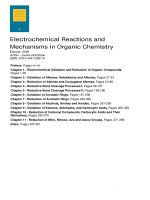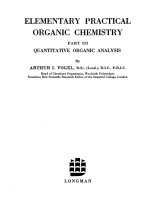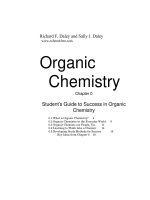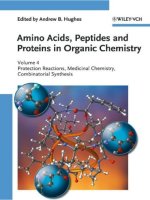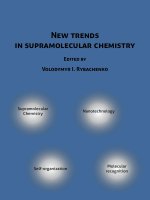Ebook Arrow pushing in organic chemistry Part 2
Bạn đang xem bản rút gọn của tài liệu. Xem và tải ngay bản đầy đủ của tài liệu tại đây (3.42 MB, 201 trang )
Chapter
6
Elimination Reactions
Until now, discussions have focused only on how carbanions and carbocations behave
under conditions favorable for nucleophilic substitutions. However, these species may
undergo other types of reactions in which unsaturation is introduced into the molecule.
Such reactions are called elimination reactions and should be considered whenever
charged species are of importance to the mechanistic progression of a molecular transformation. In previous chapters, SN1 and SN2 reactions were discussed. In this chapter, the
corresponding E1 and E2 elimination mechanisms are presented.
6.1
E1 ELIMINATIONS
Having addressed the chemistry of carbocations and associated SN1 reaction mechanisms,
it is appropriate to begin discussions of elimination reactions with the related E1 mechanism. As addressed in Chapter 5, carbocations generated from solvolysis reactions can
undergo various types of rearrangements that include hydride and alkyl shifts.
Furthermore, these shifts were rationalized when the empty p orbital associated with
the positive charge is aligned in the same plane with the migrating group. Figure 6.1 reiterates the process of hyperconjugation necessary for these shifts to occur. Furthermore,
Figure 6.2 reiterates that hyperconjugation can be viewed as introducing double-bond
character to a carbocation. Carrying this rationale one step further, if the double-bond
character in a given carbocation becomes stabilized through full dissociation of a proton,
the result, illustrated in Scheme 6.1, is formation of a full double bond through an
E1 elimination mechanism.
Arrow Pushing in Organic Chemistry: An Easy Approach to Understanding Reaction Mechanisms.
By Daniel E. Levy
Copyright # 2008 John Wiley & Sons, Inc.
101
102
ELIMINATION REACTIONS
Figure 6.1 Hyperconjugation occurs when a carbon– hydrogen bond lies in the same plane as a
carbocation’s vacant p orbital.
Figure 6.2 Hyperconjugation can be viewed as formation of a “pseudo-double-bond.”
As alluded to above, E1 reactions are integrally related to SN1 reactions by virtue of the
carbocations common to both mechanisms. Thus, revisiting the solvolysis reaction leading
to the conversion of tert-butyl bromide to MTBE illustrated in Scheme 6.2, we understand
how formation of isobutylene occurs. Formation of isobutylene only occurs through the
E1 process and comprises approximately 20 percent of the reaction mixture.
Scheme 6.1 Dissociation of a proton through hyperconjugation completes the final stage of an E1
elimination mechanism.
6.1
E1 ELIMINATIONS
103
Scheme 6.2 E1 mechanisms explain additional products observed during SN1 reactions.
Scheme 6.3 Solvolysis of 2-bromo-2,3-dimethylpentane in methanol leads to formation of up to six
different products via multiple mechanistic pathways.
104
ELIMINATION REACTIONS
As can be deduced from discussions presented above and in Chapter 5, it is very important to recognize that when designing reactions involving carbocations, both migration
reactions and elimination reactions can complicate the outcome of intended SN1 transformations. An example illustrating the potential formation of multiple side products is
shown in Scheme 6.3 with the solvolysis of 2-bromo-2,3-dimethylpentane in methanol.
Returning to Scheme 6.1, we recognize that an E1 reaction proceeds with the
Elimination of a leaving group, leading to the E designation. Because this mechanism
proceeds with the initial dissociation of a single starting material forming a carbocation,
this process is considered a unimolecular reaction. The involvement of only 1 species in
the initial phase of the reaction enhances the mechanistic designation to E1.
6.2
E2 ELIMINATIONS
To this point, considerable time has been spent discussing acids, bases, nucleophiles, and
leaving groups. These were ultimately all presented in the context of SN2 reactions. Like the
complicating side reactions associated with carbocations formed during SN1 reactions,
depending upon the nature of substituents adjacent to acidic protons, SN2 reaction conditions can induce similar complications. For example, consider a molecule with an
acidic proton and a leaving group, L, on the carbon adjacent to the acidic proton.
Consider also that nucleophiles are bases. As shown in Scheme 6.4, an alternative to
nucleophilic displacement of the leaving group is found in initial deprotonation.
Subsequent displacement of the leaving group by the resulting anion results in formation
of an olefin.
In studying Scheme 6.4, we recognize that an E2 reaction proceeds through initial
extraction of a proton by a base or nucleophile leading to Elimination of a leaving
group, justifying the E designation. Because this mechanism proceeds through the interaction of two species (substrate and base/nucleophile), E2 reactions are recognized
Scheme 6.4 SN2 Substitution reactions can occur in competition with E2 elimination reactions.
6.3
HOW DO ELIMINATION REACTIONS WORK?
105
as bimolecular. Thus, the involvement of 2 species in the initial phase of the reaction
enhances the mechanistic designation to E2. Finally, it is important to note that while
E1 reactions proceed through cationic intermediates, E2 reactions proceed through
anionic intermediates.
6.3
HOW DO ELIMINATION REACTIONS WORK?
In addressing the mechanistic basis behind elimination reactions, we must refer to
discussions surrounding carbocations in the context of SN1 reactions. Furthermore, consideration of carbocation-associated hydride/alkyl shifts and E1 related products is essential. Recall that carbocations are stabilized by phenomena such as hyperconjugation.
Furthermore, recall that hydride shifts, alkyl shifts, and E1 eliminations are dependent
upon the planar alignment of an empty p orbital and an adjacent bond bearing either a
migrating group or a dissociable hydrogen atom as illustrated in Figure 6.1.
The mechanistic basis behind the stability and reactivity of carbocations, regardless of
the reaction outcome, depends on the alignment of an empty p orbital and the orbitals comprising an adjacent bond. Specifically, if there are no planar alignments, then hyperconjugation, hydride/alkyl shifts, or eliminations cannot occur. Perhaps there is no better
illustration of this fact than a comparison of the stability of primary, secondary, and tertiary
carbocations. As reiterated from Chapter 5, Figure 6.3 illustrates the order of stability from
most stable to least stable. This trend in stability is directly related to the number of adjacent
carbon – hydrogen bonds available for hyperconjugation.
Looking at the structures shown in Figure 6.3, we notice that the tert-butyl carbocation
possesses nine carbon – hydrogen bonds adjacent to the cation, while the secondary carbocation possesses six, and the primary carbocation possesses only three. This tabulation of
bonds is relevant in that the more adjacent carbon –hydrogen bonds, the more opportunities
there are for hyperconjugation to occur. In this discussion, the term opportunities is important because single bonds employing sp 3 orbitals are not rigid and can rotate around the
bond axis as shown in Figure 6.4 in much the same way a wheel rotates on an axle.
Thus, when empty p orbitals and adjacent bonds are not in alignment, there can be no
associated orbital overlap and the observed reactions are only possible due to the intermittent alignment of a system that is continually in motion.
As already discussed, E1 and E2 eliminations differ, in part, by the electronic nature of
the mechanism. Specifically, E1 eliminations depend on cationic intermediates, whereas E2
eliminations depend on anionic intermediates. This difference, however, does not eliminate
the mechanistic similarities of these reactions as related to the necessary alignment of
adjacent chemical bonds. While, as shown in Figure 6.4, E1 eliminations require alignment
of a carbon – hydrogen bond with an adjacent empty p orbital, E2 eliminations, as shown in
Figure 6.3 Tertiary carbocations are more stable than secondary carbocations, and secondary
carbocations are more stable than primary carbocations.
106
ELIMINATION REACTIONS
Figure 6.4 When a carbon–hydrogen (or carbon–alkyl) bond is aligned with an empty p orbital,
1,2-hydride/alkyl shifts and E1 eliminations are favorable.
Figure 6.5 When a carbon– hydrogen bond is aligned trans-periplanar with a carbon-leaving group
bond, E2 eliminations are favorable.
Figure 6.5, require alignment of a carbon – hydrogen bond with an adjacent carbon-leaving
group bond. Furthermore, as shown in Figure 6.5, the relationship between these bonds is
critical for elimination to occur. Specifically, the relevant bonds must adopt a trans relationship within the same plane. This relationship is referred to as trans-periplanar.
Scheme 6.5 Rates and reactivity of substrates for potential E2 eliminations are influenced by
the presence of trans-periplanar relationships.
6.3
HOW DO ELIMINATION REACTIONS WORK?
107
Scheme 6.6 trans-Periplanar relationships lead to direct E2 eliminations.
A practical example demonstrating the importance of the trans-periplanar relationship
between protons and leaving groups is illustrated in Scheme 6.5. As shown, when treated
with base, the 1,2-cis-substituted cyclohexane analog rapidly converts to the illustrated
cyclohexene. However, the same reaction conditions applied to the 1,2-trans analog
results in conversion to the cyclohexene analog at a much slower rate. These observations
are mechanistically explained in Schemes 6.6 and 6.7. As shown in Scheme 6.6, the 1,2-cis
analog, possessing a trans-periplanar relationship, reacts through a direct E2 elimination
mechanism. However, as shown in Scheme 6.7, the 1,2-trans analog must first proceed
through deprotonation followed by delocalization of the resulting anion into the ester
Scheme 6.7 E2 eliminations can proceed in the absence of a trans-periplanar relationship in the
reaction substrate if reaction intermediates can obtain conformations that are favorable for elimination
reactions to occur.
108
ELIMINATION REACTIONS
functionality. Once the negative charge is delocalized into the ester, the anion can displace
the bromide through the intermediate double bond as illustrated with arrow pushing.
6.4
SUMMARY
In this chapter, elimination reactions were presented both independently and in association
with their related nucleophilic substitution mechanisms. Furthermore, the processes by
which molecules undergo both E1 and E2 eliminations were presented and explained
using bonding and nonbonding orbitals and their required relationships to one another.
While much emphasis was placed on the planar relationships of orbitals required for
both elimination reaction mechanisms, the special case of trans-periplanar geometries
were described as necessary for efficient E2 eliminations to occur.
While trans-periplanar relationships are important to E2 elimination reactions, it is
important to remember that, as illustrated in Schemes 6.6 and 6.7, E2 elimination reaction
mechanisms do not have to occur in a concerted manner. After deprotonation, if the
relevant orbitals do not line up, elimination will not occur until they do. Furthermore,
recall that rotation around an acyclic single bond, as illustrated in Figures 6.4 and 6.5,
occurs readily. Therefore, elimination reactions should not be removed from consideration
if a molecule is drawn in a conformation that makes these reactions appear unfavorable.
When looking at any type of nucleophilic reaction, initial identification of relevant transperiplanar relationships will aid in the identification of potential side products and their
respective mechanisms of formation.
PROBLEMS
109
PROBLEMS
1. E2 eliminations do not necessarily require acidic protons in order to proceed. Explain
how this can occur.
2. When CH3OCH2CH2CH2Br is treated with magnesium, we get the Grignard reagent
CH3OCH2CH2CH2MgBr. However, when CH3OCH2CH2Br is treated with magnesium,
the product isolated is H2C55CH2. Explain this result.
110
ELIMINATION REACTIONS
3. With an understanding of E1 mechanisms, one may realize that under SN1 reaction conditions multiple products may form. In addition to the products predicted in Chapter 5
for the following molecules, predict plausible elimination products.
a.
b.
c.
d.
PROBLEMS
111
4. Presently, several different organic reaction mechanisms have been presented. Keeping
all of these in mind, predict all of the possible products of the following reactions and list
the mechanistic type or types from which these products result.
a.
b.
c.
d.
112
ELIMINATION REACTIONS
5. As mentioned earlier, stereochemistry is not of great concern in this book. However,
certain mechanistic types will show specific stereochemical consequences when
acting on chiral molecules. With this in mind, predict the product resulting from the
E2 elimination of HBr when the shown isomer of 4-bromo-3-methyl-2-pentanone is
treated with sodamide. Show all stereochemistry and explain your answer.
6. Based on the answer to Problem 5, predict the product of the following reactions and
show all stereochemistry:
a.
b.
c.
d.
PROBLEMS
7. Explain the results of the following experiment:
113
Chapter
7
Addition Reactions
In Chapter 6, elimination reactions were presented. In the context of elimination reactions,
the formation of double bonds was noted regardless of the elimination mechanism discussed. Continuing from the concept of using elimination reactions to form sites of
unsaturation, one may reason that addition reactions can be used to remove sites of unsaturation. Thus, elaborating upon addition reactions, this chapter provides an introduction
to relevant mechanisms applied to both carbon – carbon double bonds (olefins) and
carbon – oxygen double bonds (carbonyls).
7.1
ADDITION OF HALOGENS TO DOUBLE BONDS
Throughout this book, the various mechanistic types driving reactions were shown to rely
upon interactions between charged species such as nucleophiles and electrophiles.
However, when looking at ethylene, the simplest of olefins, there are no partial charges
(or steric factors) that distinguish one side of the double bond from the other. Due to its
symmetry, there can be no pure nucleophilic or electrophilic sites. Furthermore, when
looking at bromine in its natural form of Br2, there are no interactions between the two
atoms other than a single and unpolarized bond joining them. Nevertheless, when ethylene
and bromine are brought together, the reaction illustrated in Scheme 7.1 occurs.
To explain this reaction, consider the fact that, due to the overlapping p orbitals, double
bonds are electron rich. This property allows olefins, under certain conditions, to act as
nucleophiles. In the case of a double bond reacting with molecular bromine, the result is
formation of a three-membered ring containing a positively charged bromine atom.
This three-membered ring is known as a bridged bromonium ion. Concurrent to formation
Arrow Pushing in Organic Chemistry: An Easy Approach to Understanding Reaction Mechanisms.
By Daniel E. Levy
Copyright # 2008 John Wiley & Sons, Inc.
115
116
ADDITION REACTIONS
Scheme 7.1 Addition of bromine to ethylene.
Scheme 7.2 Molecular bromine reacts with double bonds, generating a bromonium ion and a
bromide anion.
of this species, a bromide anion is displaced. The initial reaction between bromine and
ethylene is illustrated in Scheme 7.2 using arrow pushing.
Once the bromide anion becomes liberated from its parent molecular bromine, it is free
to act as a nucleophile. Due to the positive charge residing on the bridged bromonium ion,
the adjacent carbon atoms now possess partial positive charges. This is due to the positively
charged bromine pulling electron density from the carbon atoms. The electrophilic nature
of the adjacent carbon atoms is illustrated in Scheme 7.3 using resonance structures.
Because the carbon atoms are now electrophilic, they are susceptible to reaction with
the bromide anion that has dissociated as shown in Scheme 7.2. As illustrated in
Scheme 7.4, using arrow pushing, this sequence of events leads to the formation of
1,2-dibromoethane.
Scheme 7.3 Bromonium ions possess electrophilic carbon atoms.
Scheme 7.4 Nucleophilic reaction between a bromide anion and a bromonium ion generates 1,2dibromoalkanes.
7.2
7.2
MARKOVNIKOV’S RULE
117
MARKOVNIKOV’S RULE
Diatomic halogen molecules such as bromine are not the only chemicals that can add across
double bonds. In fact, any protic acid, under the proper conditions, can undergo such reactions. Specifically, as shown in Scheme 7.5, reaction of ethylene with an acid, HX, where X
is OH, CN, or any halide produces a substituted ethane.
Mechanistically, the addition of acids across double bonds is very similar to the reaction
of olefins with halogens. To understand this, it is important to recognize the electron-rich
character of double bonds described in Section 7.1. With this property of olefins in mind,
one recognizes that double bonds can become protonated under acidic conditions. As
illustrated in Scheme 7.6, protonated olefins are electronically very similar to the bromonium ion shown in Scheme 7.3 and, as such, can be described with charge-delocalized
resonance structures. Furthermore, these resonance structures are identical to those conceptually presented in Chapters 5 and 6 during discussions of hyperconjugation. Recall
that hyperconjugation is the effect leading to stabilization of carbocations (Chapter 5) as
well as being the driving force behind 1,2-hydride shifts (Chapter 6). Bringing these concepts into the addition of protic acids to olefins, the step following protonation (illustrated in
Scheme 7.7) is no different than the second step of an SN1 substition reaction.
Unlike the addition of halogens across double bonds, addition of acids results in formation of asymmetrical products. Specifically, a different group is added to each side
of the double bond. Thus, if this reaction is applied to asymmetrical olefins such as
propene, multiple products might be expected to form as illustrated in Scheme 7.8. In
fact, while a mixture of products is formed, there is an overwhelming presence of the
secondary substituted product compared to that with substitution at the primary position. This preference of reaction products resulting from addition of protic acids across
double bonds is governed by Markovnikov’s rule.
Scheme 7.5 Protic acids can add across double bonds.
Scheme 7.6 Double bonds can become protonated under acidic conditions.
118
ADDITION REACTIONS
Scheme 7.7 Nucleophiles add to protonated olefins.
Scheme 7.8 Multiple potential products are possible from addition of protic acids across
double bonds.
To understand the mechanistic basis behind Markovnikov’s rule, it is useful to refer
to the mechanisms through which acids add across double bonds. Of particular relevance
are the resonance forms of the protonated olefins illustrated in Scheme 7.6. Since, for ethylene, the two carbon atoms are both primary, there is no distinction between them. However,
as illustrated in Scheme 7.9, in the case of propene, protonation of the olefin results in
introduction of cationic character to both a primary carbon atom and a secondary
carbon atom.
Referring to the discussions presented in Chapter 5 regarding the relative stabilities of carbocations (and hyperconjugation), we are reminded that tertiary carbocations
are more stable than secondary carbocations, which, in turn, are more stable than
primary carbocations. Since, as shown in Scheme 7.9, protonation of propene results in
cationic character at both a secondary carbon and a primary carbon, a greater presence of
cationic character on the secondary site is expected compared to the primary. This allows
Scheme 7.9 Protonation of propene introduces cationic character to both primary and secondary
centers.
7.3
ADDITIONS TO CARBONYLS
119
a nucleophile to add, preferentially, to the secondary site generating the reaction outcome
presented in Scheme 7.8. Thus, in general, Markovnikov’s rule states that when an acid is
added across a double bond, the conjugate base adds to the more substituted carbon atom.
7.3
ADDITIONS TO CARBONYLS
Olefins, in the absence of attached polarizing groups, generally react as described above
with reactivity mediated through the nucleophilicity of the double bond. However, replacing one of the olefinic carbon atoms with oxygen results in formation of a polar carbonyl.
As shown in Figure 7.1, the polarity is described through placement of a partial negative
charge on the oxygen and a partial positive charge on the carbon. Discussions describing
the polarity of carbonyls (and other functional groups), based on the electronegativities
of the various atoms involved, were presented in Chapter 1. Addition reactions involving
carbonyls are discussed in the following paragraphs.
7.3.1
1,2-Additions
Because of the inherent polarity associated with carbonyl groups, nucleophiles are drawn to
the carbonyl carbon atoms in much the same way that nucleophiles participate in SN2 reactions. This mechanism, alluded to in several problems presented in previous chapters, is
illustrated in Scheme 7.10 using arrow pushing. As shown, a bonding pair of electrons
joining the carbonyl oxygen atom to its associated carbon atom acts as the leaving
group, placing a full negative charge on the oxygen atom. Generally, this type of reaction
Figure 7.1 While unsubstituted olefins are not polar, carbonyls are polar.
Scheme 7.10 Nucleophiles can add to carbonyls to form alcohols.
120
ADDITION REACTIONS
Scheme 7.11 Addition of nucleophiles to carbonyls is reversible.
produces alcohols from carbonyls. Because of the trigonal planar geometry of a carbonyl
group, there is no stereochemical preference associated with these addition reactions.
When considering reactions involving the addition of nucleophiles to carbonyls, it is
important to understand that many nucleophiles can also serve as leaving groups.
Therefore, to prevent the reverse reaction (elimination of the added nucleophile) illustrated
in Scheme 7.11, carbon-based nucleophiles are generally utilized. Such nucleophiles
include, but are not limited to, Grignard reagents, alkyllithium reagents, and potassium
cyanide. In the case of Grignard and alkyllithium reagents, the result is formation of
alcohols. Using potassium cyanide, cyanohydrins are formed. These reagents and the
products of their reactions with acetone are illustrated in Scheme 7.12.
Thus far, all examples related to the addition of nucleophiles to carbonyls involve basic
(anionic) conditions. However, such conditions are not required. Recalling that a carbonyl
oxygen atom possesses a partial negative charge, we recognize that under acidic conditions
it can be protonated. The protonation of carbonyl groups, illustrated in Scheme 7.13, was
discussed in Chapter 3. Thus, as shown in Scheme 7.14 using acetone, treatment of
Scheme 7.12 Products resulting from addition of nucleophiles to acetone.
7.3
ADDITIONS TO CARBONYLS
121
Scheme 7.13 Carbonyls can become protonated.
Scheme 7.14 Addition of nucleophiles to carbonyls can occur under acidic conditions.
Scheme 7.15 Addition of nucleophiles to simple carbonyls results in 1,2-additions.
carbonyls with acids such as HCN (hydrocyanic acid) provides another route for the formation of functional groups such as cyanohydrins.
If, as shown in Scheme 7.15, the atoms of a carbonyl are numbered with 1 representing
the oxygen and 2 representing the electrophilic carbonyl carbon atom, we notice that
addition of a nucleophile to the carbonyl results in the introduction of a new substituent
at atom 2. Therefore, this type of addition is known as a 1,2-addition.
7.3.2
1,4-Additions
The concept of SN2 reactions was presented in Chapter 4. In the context of this discussion,
the SN2 mechanism was extended to allylic systems. These allylic displacements, because
of their mechanistic similarities to SN2 reactions, were designated SN20 reactions. A representation of an SN20 mechanism, compared to an SN2 mechanism, is illustrated in
Figure 7.2 using arrow pushing.
122
ADDITION REACTIONS
Figure 7.2 Comparison of SN2 and SN2 0 reactions as explained using arrow pushing.
Scheme 7.16 Addition of nucleophiles to a,b-unsaturated carbonyl groups as explained using
arrow pushing.
In Section 7.3.1, the addition of nucleophiles to carbonyls was directly compared to SN2
reactions. In recognition of these mechanistic similarities, one may anticipate that nucleophiles can similarly add to a,b-unsaturated carbonyl systems. Such additions are, in fact,
common and, as such, are illustrated in Scheme 7.16 using arrow pushing. As shown, the
nucleophile initially adds to the double bond with delocalization of the negative charge into
the carbonyl group generating an enolate anion. Once treated with acid, the enolate anion
becomes protonated and forms an enol. Enols, being high-energy species, readily isomerize
and regenerate the carbonyl functionality.
If, as shown in Scheme 7.17, the atoms of an a,b-unsaturated carbonyl are
numbered with 1 representing the oxygen, 2 representing the carbonyl carbon atom, and
3 and 4 sequentially representing the adjacent two olefinic carbon atoms, we notice
that addition of a nucleophile in the manner illustrated in Scheme 7.16 results in the
introduction of a new substituent at atom 4. Therefore, this type of addition is known as
a 1,4-addition.
While 1,4-additions to carbonyls are common, it is important to recognize that the same
a,b-unsaturated carbonyl systems are also subject to 1,2-additions. Fortunately, these
two types of additions are highly dependent upon the form of the nucleophiles used.
7.3
ADDITIONS TO CARBONYLS
123
Scheme 7.17 Addition of nucleophiles to a,b-unsaturated carbonyls can result in 1,4-additions.
Scheme 7.18 a,b-Unsaturated carbonyl systems can be sequentially subjected to 1,4-additions and
1,2-additions.
For example, simple organometallic reagents such as alkyllithium reagents and Grignard
reagents tend to participate in 1,2-additions while organocuprates generally participate
in 1,4-additions. These trends, however, are not absolute, and the reader is referred to
general organic chemistry textbooks for broader and more detailed treatments of these
addition mechanisms.
In a final consideration regarding 1,2- and 1,4-addition reactions, a,b-unsaturated
carbonyl systems can be sequentially subjected to both mechanisms. As illustrated
in Scheme 7.18, if methyl vinyl ketone is treated first with dimethyllithiocuprate and
then with methylmagnesium bromide, the resulting product is 2-methyl-2-pentanol.
7.3.3
Addition – Elimination Reactions
In our present discussions, 1,2- and 1,4-additions to carbonyl systems were introduced.
However, these reactions were not presented in the context of specific carbonyl-based
functional groups. Expanding upon this concept, the three types of functional groups
generally used in addition reactions to carbonyls are aldehydes, ketones, and esters.
With respect to all of the above-mentioned functional groups, 1,4-additions are generally
applicable. However, of these three groups, only aldehydes and ketones are generally
useful as substrates for 1,2-additions. Figure 7.3 illustrates the products resulting from
both 1,2- and 1,4-additions of nucleophiles to aldehydes, ketones, and esters. As shown,
while the products of 1,4-additions all result in retention of the carbonyl functionality,
1,2-additions result in conversion of the respective carbonyl groups into alcohols.
However, when an ester is involved, the illustrated product is a ketone and retains the
carbonyl of the starting ester.
In examining the mechanism leading to the nucleophile-mediated conversion of an ester
to a ketone, initial addition of a nucleophile to the carbonyl results in formation of a hemiacetal intermediate. Subsequent collapse of the hemiacetal intermediate liberates a ketone
and an alkoxide leaving group. This mechanistic sequence, illustrated in Scheme 7.19
124
ADDITION REACTIONS
Figure 7.3 Unlike most carbonyl-based functional groups, nonconjugated esters can react with
nucleophiles and retain the carbonyl unit.
using arrow pushing, is known as an addition – elimination and involves initial addition of a
nucleophile to a carbonyl followed by elimination of an alkoxide leaving group. As a cautionary note, the conversion of esters to ketones can be difficult to control due to sequential
reaction of the newly formed ketones with nucleophiles present in the reaction mixture.
Addition – elimination reactions are not exclusive to esters. In fact, these reactions can
occur with any carbonyl-based system where the leaving group is a weaker nucleophile
Scheme 7.19 The addition– elimination mechanism illustrated with arrow pushing.
7.4
SUMMARY
125
Figure 7.4 Functional groups capable of participating in addition– elimination reactions.
than that initially reacting. Such systems, illustrated in Figure 7.4, include, but are not
limited to, esters, acid halides, thioesters, and carbonates. Finally, when predicting the
products of potential addition – elimination reactions, guidance is readily obtained
through consideration of the relative pKa values of the respective nucleophiles and
leaving groups.
7.4
SUMMARY
In this chapter, the principles presented in Chapter 4 (SN2 reactions) were extended into
olefinic and carbonyl-based systems. In exploring these areas, the electronic properties
and nucleophilic/electrophilic nature of these groups were discussed. Finally, discussions
of nucleophilic additions into these functionalities were extended into conjugated
unsaturated systems leading to strategies for the incorporation of diverse modifications to
relatively simple substrates. Specifically, this diversity of modifications becomes much
more apparent when combining the principles presented in this chapter with those of
Chapters 4 and 6. All of these principles will be useful when working through the problems
of this chapter as well as advancing through introductory organic chemistry coursework.

